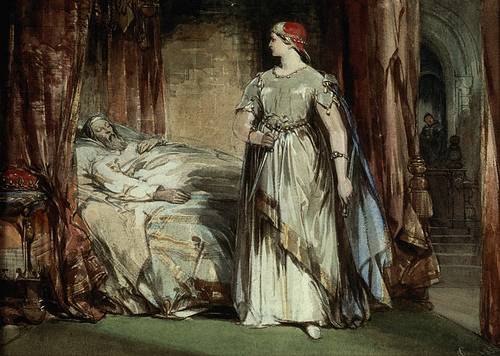While completing his last movie, James Dean filmed a safe-driving announcement aimed at teenagers.
“The life you save,” he concluded, “may be mine.”
While completing his last movie, James Dean filmed a safe-driving announcement aimed at teenagers.
“The life you save,” he concluded, “may be mine.”

Actors traditionally refer to Macbeth as “the Scottish play” rather than by name. Supposedly the witches cast real spells, cursing the play with fatal accidents — beginning with the original production, when an actor was stabbed with a real dagger mistaken for a prop.
According to tradition, anyone who speaks the actual name of the play in a theater must leave, spit or turn around three times, and be invited back in.
There was a young lady from Bude
Who went for a swim in the lake
A man in a punt
Stuck an oar in her ear
And said, “You can’t swim here, it’s private.”
— Anonymous
“Can’t Be Done”:
— Sam Loyd’s Cyclopedia of 5000 Puzzles, Tricks, and Conundrums (With Answers), 1914

You can float in the Dead Sea without getting your newspaper wet.
The water’s saltiness makes floating objects unusually buoyant.
claustrophilia
n. the liking of small, enclosed spaces

In October 1995 a group of Welsh high-school students discovered a 2-inch frog alive inside an old ring-pull can. The frog was much larger than the can’s opening, so it must have entered when it was small; the can’s sell-by date was May 1994, so it may have been trapped for a year or more.
How did it stay alive all that time? Possibly its odor attracted bugs, and rain and dew could have reached it through the can’s hole.
But possibly some animals can survive long periods with practically no resources. In the 19th century, English geologist William Buckland deliberately buried two dozen toads in chambers of limestone, sealing them in with a sheet of glass. The little ones survived for 13 months, he found, the big ones a few months longer.
That’s impressive, but there are limits, of course. Texas legend tells of “Old Rip,” a horned toad accidentally sealed in a courthouse cornerstone in 1897. When the building was demolished 31 years later, Rip supposedly hopped out. That sounds ridiculous, but supporters insist that the witnesses included two judges and a pastor. You can judge for yourself: Rip’s remains are on display at the Eastland County Courthouse.
I am greater than God, and more evil than the devil. Poor people have me. Rich people want me. And if you eat me, you’ll die. What am I?
Uncle Billy rested his axe on the log he was chopping, and turned his grizzly old head to one side, listening intently. A confusion of sounds came from the little cabin across the road. It was a dilapidated negro cabin, with its roof awry and the weather-boarding off in great patches; still, it was a place of interest to Uncle Billy. His sister lived there with three orphan grandchildren.
Leaning heavily on his axe-handle, he thrust out his under lip, and rolled his eyes in the direction of the uproar. A broad grin spread over his wrinkled black face as he heard the rapid spank of a shingle, the scolding tones of an angry voice, and a prolonged howl.
“John Jay an’ he gran’mammy ‘peah to be havin’ a right sma’t difference of opinion togethah this mawnin’,” he chuckled.
— Annie Fellows Johnston, Ole Mammy’s Torment, 1897
Handbill circulated in Dallas on Nov. 21, 1963, the day before Kennedy’s assassination:
